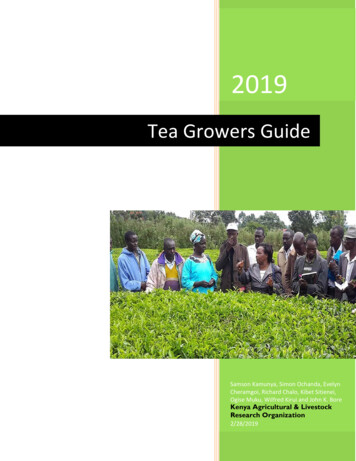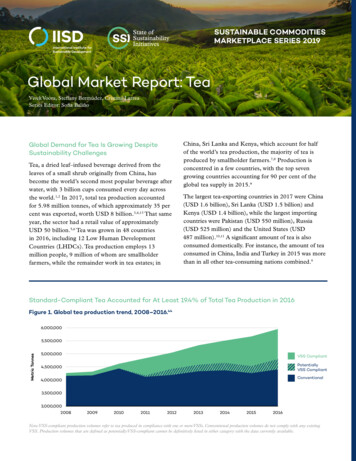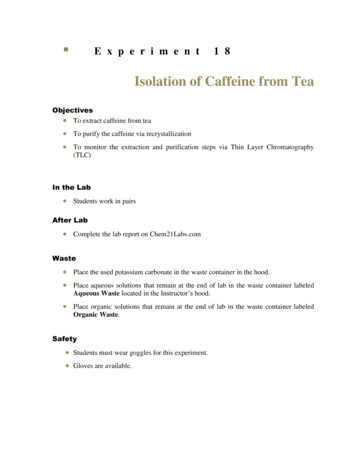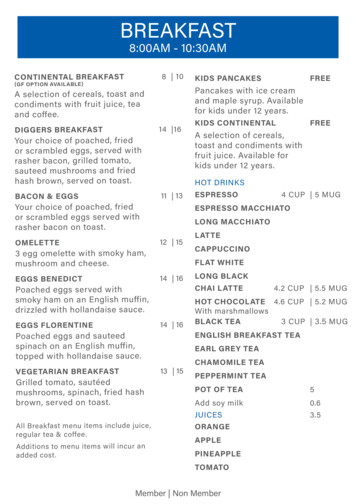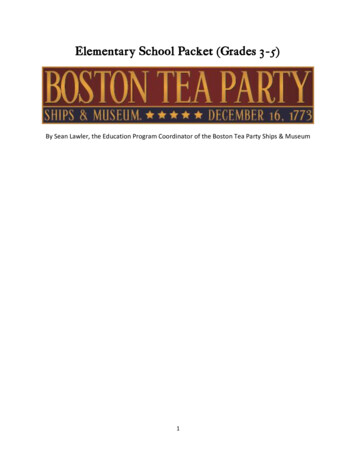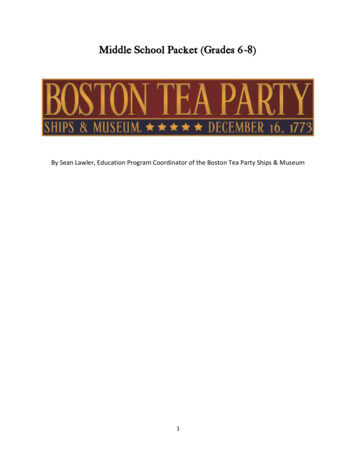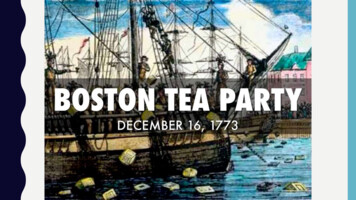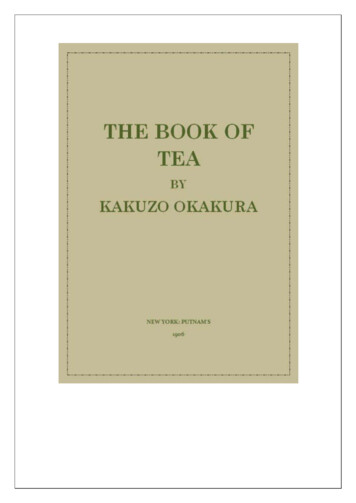
Transcription
THE BOOK OF TEABYKAKUZO OKAKURANEW YORK: PUTNAM'SORIGINALLY PUBLISHED IN 1906In the Public Domain because a) was published before 1923, and b), author died in 1913,making it applicable to Life 70 countries.
The Book Of Tea By Kakuzo Okakura.This edition created and published by Global Grey 2014.GLOBAL GREYNOTHING BUT E-BOOKS
TABLE OF CONTENTSI. THE CUP OF HUMANITYII. THE SCHOOLS OF TEAIII. TAOISM AND ZENNISMIV. THE TEA-ROOMV. ART APPRECIATIONVI. FLOWERSVII. TEA-MASTERS
1The Book Of Tea By Kakuzo OkakuraI. THE CUP OF HUMANITYTea began as a medicine and grew into a beverage. In China, in the eighthcentury, it entered the realm of poetry as one of the polite amusements.The fifteenth century saw Japan ennoble it into a religion of aestheticism-Teaism. Teaism is a cult founded on the adoration of the beautiful amongthe sordid facts of everyday existence. It inculcates purity and harmony,the mystery of mutual charity, the romanticism of the social order. It isessentially a worship of the Imperfect, as it is a tender attempt toaccomplish something possible in this impossible thing we know as life.The Philosophy of Tea is not mere aestheticism in the ordinary acceptanceof the term, for it expresses conjointly with ethics and religion our wholepoint of view about man and nature. It is hygiene, for it enforcescleanliness; it is economics, for it shows comfort in simplicity rather thanin the complex and costly; it is moral geometry, inasmuch as it defines oursense of proportion to the universe. It represents the true spirit of Easterndemocracy by making all its votaries aristocrats in taste.The long isolation of Japan from the rest of the world, so conducive tointrospection, has been highly favourable to the development of Teaism.Our home and habits, costume and cuisine, porcelain, lacquer, painting-our very literature--all have been subject to its influence. No student ofJapanese culture could ever ignore its presence. It has permeated theelegance of noble boudoirs, and entered the abode of the humble. Ourpeasants have learned to arrange flowers, our meanest labourer to offerhis salutation to the rocks and waters. In our common parlance we speakof the man "with no tea" in him, when he is insusceptible to the seriocomic interests of the personal drama. Again we stigmatise the untamedaesthete who, regardless of the mundane tragedy, runs riot in thespringtide of emancipated emotions, as one "with too much tea" in him.The outsider may indeed wonder at this seeming much ado aboutnothing. What a tempest in a tea-cup! he will say. But when we considerhow small after all the cup of human enjoyment is, how soon overflowedwith tears, how easily drained to the dregs in our quenchless thirst forinfinity, we shall not blame ourselves for making so much of the tea-cup.Mankind has done worse. In the worship of Bacchus, we have sacrificedtoo freely; and we have even transfigured the gory image of Mars. Whynot consecrate ourselves to the queen of the Camelias, and revel in thewww.globalgrey.co.uk
2The Book Of Tea By Kakuzo Okakurawarm stream of sympathy that flows from her altar? In the liquid amberwithin the ivory-porcelain, the initiated may touch the sweet reticence ofConfucius, the piquancy of Laotse, and the ethereal aroma of Sakyamunihimself.Those who cannot feel the littleness of great things in themselves are aptto overlook the greatness of little things in others. The averageWesterner, in his sleek complacency, will see in the tea ceremony butanother instance of the thousand and one oddities which constitute thequaintness and childishness of the East to him. He was wont to regardJapan as barbarous while she indulged in the gentle arts of peace: he callsher civilised since she began to commit wholesale slaughter onManchurian battlefields. Much comment has been given lately to theCode of the Samurai, --the Art of Death which makes our soldiers exult inself- sacrifice; but scarcely any attention has been drawn to Teaism, whichrepresents so much of our Art of Life. Fain would we remain barbarians, ifour claim to civilisation were to be based on the gruesome glory of war.Fain would we await the time when due respect shall be paid to our artand ideals.When will the West understand, or try to understand, the East? WeAsiatics are often appalled by the curious web of facts and fancies whichhas been woven concerning us. We are pictured as living on the perfumeof the lotus, if not on mice and cockroaches. It is either impotentfanaticism or else abject voluptuousness. Indian spirituality has beenderided as ignorance, Chinese sobriety as stupidity, Japanese patriotismas the result of fatalism. It has been said that we are less sensible to painand wounds on account of the callousness of our nervous organisation!Why not amuse yourselves at our expense? Asia returns the compliment.There would be further food for merriment if you were to know all thatwe have imagined and written about you. All the glamour of theperspective is there, all the unconscious homage of wonder, all the silentresentment of the new and undefined. You have been loaded with virtuestoo refined to be envied, and accused of crimes too picturesque to becondemned. Our writers in the past--the wise men who knew--informedus that you had bushy tails somewhere hidden in your garments, andoften dined off a fricassee of newborn babes! Nay, we had somethingworse against you: we used to think you the most impracticable peopleon the earth, for you were said to preach what you never practiced.www.globalgrey.co.uk
3The Book Of Tea By Kakuzo OkakuraSuch misconceptions are fast vanishing amongst us. Commerce has forcedthe European tongues on many an Eastern port. Asiatic youths areflocking to Western colleges for the equipment of modern education. Ourinsight does not penetrate your culture deeply, but at least we are willingto learn. Some of my compatriots have adopted too much of yourcustoms and too much of your etiquette, in the delusion that theacquisition of stiff collars and tall silk hats comprised the attainment ofyour civilisation. Pathetic and deplorable as such affectations are, theyevince our willingness to approach the West on our knees. Unfortunatelythe Western attitude is unfavourable to the understanding of the East.The Christian missionary goes to impart, but not to receive. Yourinformation is based on the meagre translations of our immenseliterature, if not on the unreliable anecdotes of passing travellers. It israrely that the chivalrous pen of a Lafcadio Hearn or that of the author of"The Web of Indian Life" enlivens the Oriental darkness with the torch ofour own sentiments.Perhaps I betray my own ignorance of the Tea Cult by being so outspoken.Its very spirit of politeness exacts that you say what you are expected tosay, and no more. But I am not to be a polite Teaist. So much harm hasbeen done already by the mutual misunderstanding of the New Worldand the Old, that one need not apologise for contributing his tithe to thefurtherance of a better understanding. The beginning of the twentiethcentury would have been spared the spectacle of sanguinary warfare ifRussia had condescended to know Japan better. What dire consequencesto humanity lie in the contemptuous ignoring of Eastern problems!European imperialism, which does not disdain to raise the absurd cry ofthe Yellow Peril, fails to realise that Asia may also awaken to the cruelsense of the White Disaster. You may laugh at us for having "too muchtea," but may we not suspect that you of the West have "no tea" in yourconstitution?Let us stop the continents from hurling epigrams at each other, and besadder if not wiser by the mutual gain of half a hemisphere. We havedeveloped along different lines, but there is no reason why one shouldnot supplement the other. You have gained expansion at the cost ofrestlessness; we have created a harmony which is weak againstaggression. Will you believe it?--the East is better off in some respectsthan the West!www.globalgrey.co.uk
4The Book Of Tea By Kakuzo OkakuraStrangely enough humanity has so far met in the tea-cup. It is the onlyAsiatic ceremonial which commands universal esteem. The white man hasscoffed at our religion and our morals, but has accepted the brownbeverage without hesitation. The afternoon tea is now an importantfunction in Western society. In the delicate clatter of trays and saucers, inthe soft rustle of feminine hospitality, in the common catechism aboutcream and sugar, we know that the Worship of Tea is established beyondquestion. The philosophic resignation of the guest to the fate awaitinghim in the dubious decoction proclaims that in this single instance theOriental spirit reigns supreme.The earliest record of tea in European writing is said to be found in thestatement of an Arabian traveller, that after the year 879 the mainsources of revenue in Canton were the duties on salt and tea. Marco Polorecords the deposition of a Chinese minister of finance in 1285 for hisarbitrary augmentation of the tea-taxes. It was at the period of the greatdiscoveries that the European people began to know more about theextreme Orient. At the end of the sixteenth century the Hollandersbrought the news that a pleasant drink was made in the East from theleaves of a bush. The travellers Giovanni Batista Ramusio (1559), L.Almeida (1576), Maffeno (1588), Tareira (1610), also mentioned tea. Inthe last-named year ships of the Dutch East India Company brought thefirst tea into Europe. It was known in France in 1636, and reached Russiain 1638. England welcomed it in 1650 and spoke of it as "That excellentand by all physicians approved China drink, called by the Chineans Tcha,and by other nations Tay, alias Tee."Like all good things of the world, the propaganda of Tea met withopposition. Heretics like Henry Saville (1678) denounced drinking it as afilthy custom. Jonas Hanway (Essay on Tea, 1756) said that men seemedto lose their stature and comeliness, women their beauty through the useof tea. Its cost at the start (about fifteen or sixteen shillings a pound)forbade popular consumption, and made it "regalia for high treatmentsand entertainments, presents being made thereof to princes andgrandees." Yet in spite of such drawbacks tea-drinking spread withmarvellous rapidity. The coffee-houses of London in the early half of theeighteenth century became, in fact, tea-houses, the resort of wits likeAddison and Steele, who beguiled themselves over their "dish of tea." Thebeverage soon became a necessity of life--a taxable matter. We arereminded in this connection what an important part it plays in modernwww.globalgrey.co.uk
5The Book Of Tea By Kakuzo Okakurahistory. Colonial America resigned herself to oppression until humanendurance gave way before the heavy duties laid on Tea. Americanindependence dates from the throwing of tea-chests into Boston harbour.There is a subtle charm in the taste of tea which makes it irresistible andcapable of idealisation. Western humourists were not slow to mingle thefragrance of their thought with its aroma. It has not the arrogance ofwine, the self- consciousness of coffee, nor the simpering innocence ofcocoa. Already in 1711, says the Spectator: "I would therefore in aparticular manner recommend these my speculations to all well-regulatedfamilies that set apart an hour every morning for tea, bread and butter;and would earnestly advise them for their good to order this paper to bepunctually served up and to be looked upon as a part of the teaequipage." Samuel Johnson draws his own portrait as "a hardened andshameless tea drinker, who for twenty years diluted his meals with onlythe infusion of the fascinating plant; who with tea amused the evening,with tea solaced the midnight, and with tea welcomed the morning."Charles Lamb, a professed devotee, sounded the true note of Teaismwhen he wrote that the greatest pleasure he knew was to do a goodaction by stealth, and to have it found out by accident. For Teaism is theart of concealing beauty that you may discover it, of suggesting what youdare not reveal. It is the noble secret of laughing at yourself, calmly yetthoroughly, and is thus humour itself,--the smile of philosophy. Allgenuine humourists may in this sense be called tea-philosophers,-Thackeray, for instance, and of course, Shakespeare. The poets of theDecadence (when was not the world in decadence?), in their protestsagainst materialism, have, to a certain extent, also opened the way toTeaism. Perhaps nowadays it is our demure contemplation of theImperfect that the West and the East can meet in mutual consolation.The Taoists relate that at the great beginning of the No-Beginning, Spiritand Matter met in mortal combat. At last the Yellow Emperor, the Sun ofHeaven, triumphed over Shuhyung, the demon of darkness and earth. TheTitan, in his death agony, struck his head against the solar vault andshivered the blue dome of jade into fragments. The stars lost their nests,the moon wandered aimlessly among the wild chasms of the night. Indespair the Yellow Emperor sought far and wide for the repairer of theHeavens. He had not to search in vain. Out of the Eastern sea rose aqueen, the divine Niuka, horn-crowned and dragon-tailed, resplendent inwww.globalgrey.co.uk
6The Book Of Tea By Kakuzo Okakuraher armor of fire. She welded the five-coloured rainbow in her magiccauldron and rebuilt the Chinese sky. But it is told that Niuka forgot to filltwo tiny crevices in the blue firmament. Thus began the dualism of love-two souls rolling through space and never at rest until they join togetherto complete the universe. Everyone has to build anew his sky of hope andpeace.The heaven of modern humanity is indeed shattered in the Cyclopeanstruggle for wealth and power. The world is groping in the shadow ofegotism and vulgarity. Knowledge is bought through a bad conscience,benevolence practiced for the sake of utility. The East and the West, liketwo dragons tossed in a sea of ferment, in vain strive to regain the jewelof life. We need a Niuka again to repair the grand devastation; we awaitthe great Avatar. Meanwhile, let us have a sip of tea. The afternoon glowis brightening the bamboos, the fountains are bubbling with delight, thesoughing of the pines is heard in our kettle. Let us dream of evanescence,and linger in the beautiful foolishness of things.www.globalgrey.co.uk
7The Book Of Tea By Kakuzo OkakuraII. THE SCHOOLS OF TEATea is a work of art and needs a master hand to bring out its noblestqualities. We have good and bad tea, as we have good and bad paintings-generally the latter. There is no single recipe for making the perfect tea,as there are no rules for producing a Titian or a Sesson. Each preparationof the leaves has its individuality, its special affinity with water and heat,its own method of telling a story. The truly beautiful must always be in it.How much do we not suffer through the constant failure of society torecognise this simple and fundamental law of art and life; Lichilai, a Sungpoet, has sadly remarked that there were three most deplorable things inthe world: the spoiling of fine youths through false education, thedegradation of fine art through vulgar admiration, and the utter waste offine tea through incompetent manipulation.Like Art, Tea has its periods and its schools. Its evolution may be roughlydivided into three main stages: the Boiled Tea, the Whipped Tea, and theSteeped Tea. We moderns belong to the last school. These severalmethods of appreciating the beverage are indicative of the spirit of theage in which they prevailed. For life is an expression, our unconsciousactions the constant betrayal of our innermost thought. Confucius saidthat "man hideth not." Perhaps we reveal ourselves too much in smallthings because we have so little of the great to conceal. The tiny incidentsof daily routine are as much a commentary of racial ideals as the highestflight of philosophy or poetry. Even as the difference in favorite vintagemarks the separate idiosyncrasies of different periods and nationalities ofEurope, so the Tea-ideals characterise the various moods of Orientalculture. The Cake-tea which was boiled, the Powdered-tea which waswhipped, the Leaf-tea which was steeped, mark the distinct emotionalimpulses of the Tang, the Sung, and the Ming dynasties of China. If wewere inclined to borrow the much-abused terminology of artclassification, we might designate them respectively, the Classic, theRomantic, and the Naturalistic schools of Tea.The tea-plant, a native of southern China, was known from very earlytimes to Chinese botany and medicine. It is alluded to in the classics underthe various names of Tou, Tseh, Chung, Kha, and Ming, and was highlyprized for possessing the virtues of relieving fatigue, delighting the soul,strengthening the will, and repairing the eyesight. It was not onlyadministered as an internal dose, but often applied externally in form ofwww.globalgrey.co.uk
8The Book Of Tea By Kakuzo Okakurapaste to alleviate rheumatic pains. The Taoists claimed it as an importantingredient of the elixir of immortality. The Buddhists used it extensively toprevent drowsiness during their long hours of meditation.By the fourth and fifth centuries Tea became a favourite beverage amongthe inhabitants of the Yangtse-Kiang valley. It was about this time thatmodern ideograph Cha was coined, evidently a corruption of the classicTou. The poets of the southern dynasties have left some fragments oftheir fervent adoration of the "froth of the liquid jade." Then emperorsused to bestow some rare preparation of the leaves on their highministers as a reward for eminent services. Yet the method of drinking teaat this stage was primitive in the extreme. The leaves were steamed,crushed in a mortar, made into a cake, and boiled together with rice,ginger, salt, orange peel, spices, milk, and sometimes with onions! Thecustom obtains at the present day among the Thibetans and variousMongolian tribes, who make a curious syrup of these ingredients. The useof lemon slices by the Russians, who learned to take tea from the Chinesecaravansaries, points to the survival of the ancient method.It needed the genius of the Tang dynasty to emancipate Tea from itscrude state and lead to its final idealization. With Luwuh in the middle ofthe eighth century we have our first apostle of tea. He was born in an agewhen Buddhism, Taoism, and Confucianism were seeking mutualsynthesis. The pantheistic symbolism of the time was urging one to mirrorthe Universal in the Particular. Luwuh, a poet, saw in the Tea-service thesame harmony and order which reigned through all things. In hiscelebrated work, the "Chaking" (The Holy Scripture of Tea) he formulatedthe Code of Tea. He has since been worshipped as the tutelary god of theChinese tea merchants.The "Chaking" consists of three volumes and ten chapters. In the firstchapter Luwuh treats of the nature of the tea-plant, in the second of theimplements for gathering the leaves, in the third of the selection of theleaves. According to him the best quality of the leaves must have "creaseslike the leathern boot of Tartar horsemen, curl like the dewlap of a mightybullock, unfold like a mist rising out of a ravine, gleam like a lake touchedby a zephyr, and be wet and soft like fine earth newly swept by rain."The fourth chapter is devoted to the enumeration and description of thetwenty-four members of the tea-equipage, beginning with the tripodwww.globalgrey.co.uk
9The Book Of Tea By Kakuzo Okakurabrazier and ending with the bamboo cabinet for containing all theseutensils. Here we notice Luwuh's predilection for Taoist symbolism. Also itis interesting to observe in this connection the influence of tea on Chineseceramics. The Celestial porcelain, as is well known, had its origin in anattempt to reproduce the exquisite shade of jade, resulting, in the Tangdynasty, in the blue glaze of the south, and the white glaze of the north.Luwuh considered the blue as the ideal colour for the tea-cup, as it lentadditional greenness to the beverage, whereas the white made it lookpinkish and distasteful. It was because he used cake-tea. Later on, whenthe tea masters of Sung took to the powdered tea, they preferred heavybowls of blue-black and dark brown. The Mings, with their steeped tea,rejoiced in light ware of white porcelain.In the fifth chapter Luwuh describes the method of making tea. Heeliminates all ingredients except salt. He dwells also on the muchdiscussed question of the choice of water and the degree of boiling it.According to him, the mountain spring is the best, the river water and thespring water come next in the order of excellence. There are three stagesof boiling: the first boil is when the little bubbles like the eye of fishesswim on the surface; the second boil is when the bubbles are like crystalbeads rolling in a fountain; the third boil is when the billows surge wildlyin the kettle. The Cake-tea is roasted before the fire until it becomes softlike a baby's arm and is shredded into powder between pieces of finepaper. Salt is put in the first boil, the tea in the second. At the third boil, adipperful of cold water is poured into the kettle to settle the tea andrevive the "youth of the water." Then the beverage was poured into cupsand drunk. O nectar! The filmy leaflet hung like scaly clouds in a serenesky or floated like waterlilies on emerald streams. It was of such abeverage that Lotung, a Tang poet, wrote: "The first cup moistens my lipsand throat, the second cup breaks my loneliness, the third cup searchesmy barren entrail but to find therein some five thousand volumes of oddideographs. The fourth cup raises a slight perspiration,--all the wrong oflife passes away through my pores. At the fifth cup I am purified; the sixthcup calls me to the realms of the immortals. The seventh cup--ah, but Icould take no more! I only feel the breath of cool wind that rises in mysleeves. Where is Horaisan? Let me ride on this sweet breeze and waftaway thither."The remaining chapters of the "Chaking" treat of the vulgarity of theordinary methods of tea-drinking, a historical summary of illustrious tea-www.globalgrey.co.uk
10The Book Of Tea By Kakuzo Okakuradrinkers, the famous tea plantations of China, the possible variations ofthe tea-service and illustrations of the tea-utensils. The last isunfortunately lost.The appearance of the "Chaking" must have created considerablesensation at the time. Luwuh was befriended by the Emperor Taisung(763-779), and his fame attracted many followers. Some exquisites weresaid to have been able to detect the tea made by Luwuh from that of hisdisciples. One mandarin has his name immortalised by his failure toappreciate the tea of this great master.In the Sung dynasty the whipped tea came into fashion and created thesecond school of Tea. The leaves were ground to fine powder in a smallstone mill, and the preparation was whipped in hot water by a delicatewhisk made of split bamboo. The new process led to some change in thetea-equippage of Luwuh, as well as in the choice of leaves. Salt wasdiscarded forever. The enthusiasm of the Sung people for tea knew nobounds. Epicures vied with each other in discovering new varieties, andregular tournaments were held to decide their superiority. The EmperorKiasung (1101-1124), who was too great an artist to be a well-behavedmonarch, lavished his treasures on the attainment of rare species. Hehimself wrote a dissertation on the twenty kinds of tea, among which heprizes the "white tea" as of the rarest and finest quality.The tea-ideal of the Sungs differed from the Tangs even as their notion oflife differed. They sought to actualize what their predecessors tried tosymbolise. To the Neo-Confucian mind the cosmic law was not reflectedin the phenomenal world, but the phenomenal world was the cosmic lawitself. Aeons were but moments--Nirvana always within grasp. The Taoistconception that immortality lay in the eternal change permeated all theirmodes of thought. It was the process, not the deed, which wasinteresting. It was the completing, not the completion, which was reallyvital. Man came thus at once face to face with nature. A new meaninggrew into the art of life. The tea began to be not a poetical pastime, butone of the methods of self-realisation. Wangyucheng eulogised tea as"flooding his soul like a direct appeal, that its delicate bitterness remindedhim of the aftertaste of a good counsel." Sotumpa wrote of the strengthof the immaculate purity in tea which defied corruption as a truly virtuousman. Among the Buddhists, the southern Zen sect, which incorporated somuch of Taoist doctrines, formulated an elaborate ritual of tea. Thewww.globalgrey.co.uk
11The Book Of Tea By Kakuzo Okakuramonks gathered before the image of Bodhi Dharma and drank tea out of asingle bowl with the profound formality of a holy sacrament. It was thisZen ritual which finally developed into the Tea-ceremony of Japan in thefifteenth century.Unfortunately the sudden outburst of the Mongol tribes in the thirteenthcentury which resulted in the devastation and conquest of China underthe barbaric rule of the Yuen Emperors, destroyed all the fruits of Sungculture. The native dynasty of the Mings which attempted renationalisation in the middle of the fifteenth century was harassed byinternal troubles, and China again fell under the alien rule of the Manchusin the seventeenth century. Manners and customs changed to leave novestige of the former times. The powdered tea is entirely forgotten. Wefind a Ming commentator at loss to recall the shape of the tea whiskmentioned in one of the Sung classics. Tea is now taken by steeping theleaves in hot water in a bowl or cup. The reason why the Western world isinnocent of the older method of drinking tea is explained by the fact thatEurope knew it only at the close of the Ming dynasty.To the latter-day Chinese tea is a delicious beverage, but not an ideal. Thelong woes of his country have robbed him of the zest for the meaning oflife. He has become modern, that is to say, old and disenchanted. He haslost that sublime faith in illusions which constitutes the eternal youth andvigour of the poets and ancients. He is an eclectic and politely accepts thetraditions of the universe. He toys with Nature, but does not condescendto conquer or worship her. His Leaf-tea is often wonderful with its flowerlike aroma, but the romance of the Tang and Sung ceremonials are not tobe found in his cup.Japan, which followed closely on the footsteps of Chinese civilisation, hasknown the tea in all its three stages. As early as the year 729 we read ofthe Emperor Shomu giving tea to one hundred monks at his palace inNara. The leaves were probably imported by our ambassadors to the TangCourt and prepared in the way then in fashion. In 801 the monk Saichobrought back some seeds and planted them in Yeisan. Many tea-gardensare heard of in succeeding centuries, as well as the delight of thearistocracy and priesthood in the beverage. The Sung tea reached us in1191 with the return of Yeisai-zenji, who went there to study thesouthern Zen school. The new seeds which he carried home weresuccessfully planted in three places, one of which, the Uji district nearwww.globalgrey.co.uk
12The Book Of Tea By Kakuzo OkakuraKioto, bears still the name of producing the best tea in the world. Thesouthern Zen spread with marvellous rapidity, and with it the tea-ritualand the tea-ideal of the Sung. By the fifteenth century, under thepatronage of the Shogun, Ashikaga-Voshinasa, the tea ceremony is fullyconstituted and made into an independent and secular performance.Since then Teaism is fully established in Japan. The use of the steeped teaof the later China is comparatively recent among us, being only knownsince the middle of the seventeenth century. It has replaced thepowdered tea in ordinary consumption, though the latter still continuesto hold its place as the tea of teas.It is in the Japanese tea ceremony that we see the culmination of teaideals. Our successful resistance of the Mongol invasion in 1281 hadenabled us to carry on the Sung movement so disastrously cut off in Chinaitself through the nomadic inroad. Tea with us became more than anidealisation of the form of drinking; it is a religion of the art of life. Thebeverage grew to be an excuse for the worship of purity and refinement,a sacred function at which the host and guest joined to produce for thatoccasion the utmost beatitude of the mundane. The tea-room was anoasis in the dreary waste of existence where weary travellers could meetto drink from the common spring of art- appreciation. The ceremony wasan improvised drama whose plot was woven about the tea, the flowers,and the paintings. Not a colour to disturb the tone of the room, not asound to mar the rhythm of things, not a gesture to obtrude on theharmony, not a word to break the unity of the surroundings, allmovements to be performed simply and naturally--such were the aims ofthe tea- ceremony. And strangely enough it was often successful. A subtlephilosophy lay behind it all. Teaism was Taoism in disguise.www.globalgrey.co.uk
13The Book Of Tea By Kakuzo OkakuraIII. TAOISM AND ZENNISMThe connection of Zennism with tea is proverbial. We have alreadyremarked that the tea-ceremony was a development of the Zen ritual.The name of Laotse, the founder of Taoism, is also intimately associatedwith the history of tea. It is written in the Chinese school manualconcerning the origin of habits and customs that the ceremony of offeringtea to a guest began with Kwanyin, a well-known disciple of Laotse, whofirst at the gate of the Han Pass presented to the "Old Philosopher" a cupof the golden elixir. We shall not stop to discuss the authenticity of suchtales, which are valuable, however, as confirming the early use of thebeverage by the Taoists. Our interest in Taoism and Ze
THE BOOK OF TEA . BY. KAKUZO OKAKURA. NEW YORK: PUTNAM'S . ORIGINALLY PUBLISHED IN 1906 . In the Public Domain because a) was published before 1923, and b), author died in 1913, making it applicable to Life 70 countries. The Book Of Tea By Kakuzo Okakura. This edition created and published by Global Grey 2014.
